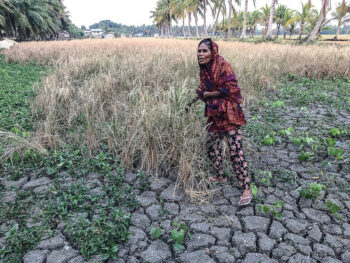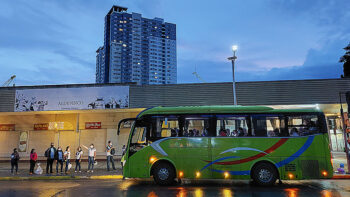
MALITA, Davao Occidental (MindaNews / 07 July) — With the preference of Malacañang under the new administration for vloggers over journalists to cover its activities and influencers peddling their opinion online that history is nothing but gossip, I thought it worthwhile to write about the history of the name of Malita, the capital of the province of Davao Occidental. A popular story of its origin seems to be the accepted “history” of the town. The story is amusing but downright discourteous to the original inhabitants of the land.
I have been living in the mountains of Malita for the last eleven years or so. I have been working with the Tagakolu people through the Malita Tagakaulo Mission (MATAMIS) of the Diocese of Digos. Malita is a laidback coastal town with a lot of potential for progress. Malita is the capital of the province of Davao Occidental, a fledgling province carved out of the province of Davao del Sur, and has a land area of 883.37 square kilometers. According to the Philippine Statistics Authority, Malita has a population of 118,197 inhabitants as of the 2020 census. To the north of Malita is the town of Sta. Maria and to the south is Don Marcelino. Malita is bounded by the Davao Gulf to the East and by Malungon, Sarangani to the west.
The western side of Malita is mountainous and is home to the Tagakolu who account for the greater percentage of the indigenous population (History, 2017). Malita’s economy is largely agricultural based. It also has rich fisheries and marine resources.
In one of my visits to the Tagakolu communities during my first years in Malita, I chanced upon a high school yearbook in the house of a lay leader where I was to spend the night. In one of the pages was cited the origin of the name of the town. It was an interesting read at the time. It so happens that the same story is found in the Wikipedia entry about Malita under the heading “etymology.”
According to folk etymology, the name “Malita” is derived from the Spanish word “maleta” which means suitcase. It is said that purportedly Don Mariano Peralta, a retired veteran of the Spanish-American War who ventured to the place, decided to live on the vast, fertile plain across the river. One day while bodily fording the deep and swift river with his suitcase and other belongings in hand, the force of the current overwhelmed his perilous balance and got swept by the water consequently losing his grip on the suitcase. His frantic shouts of “maleta, maleta” attracted the attention of the bathing natives who, after realizing the situation, promptly responded and retrieved the vanishing suitcase. Hardly forgetting the shouts of Peralta, the natives later thought the word referred to the land he intended to settle as Malita. How it came to its present spelling and usage may be attributed to the natives’ prevalent use of long “e” sound for the vowels “i” and “e” (Malita, 2022) .
The story is interesting because Malita had been inhabited by the Tagakolu, Blaan and Manobo long before the arrival of Peralta, the protagonist in the story! Furthermore, the name “Malita” was already in use at the time and had no relation whatsoever to the alleged suitcase of Peralta.
The place that is referred to at present as the municipality of Malita has long been inhabited by the Tagakolu, Blaan and Manobo communities even before the arrival of Spanish missionaries. Interestingly, these communities are not mentioned in the “folk etymology” mentioned in Wikipedia, although there is a mention of “natives” in the story. If you were to read the history section of the same Wikipedia entry, there is again no mention of the names of these communities but cites that migrants had come from the Visayan islands and Luzon, which led to the increase in the population “until it later became the most populous municipality in the province” (Ibid.). There is glaringly no mention of the Tagakolu, Blaan and Manobo!
On the one hand, it does not come as a surprise. The Indigenous Peoples are often relegated to the sidelines of history. Colonizers, settlers and foreigners take center stage instead because it is their version of events that often makes it to books and not that of the original inhabitants. This is why the misdeeds of well-meaning albeit ignorant outsiders could be cited as heroic acts by writers while actually perceived as pointless, rude or even downright irrational by the inhabitants of the land.
On the other hand, it is tragic. In this day and age, I would have thought that Filipinos and the government would have learned from our mistakes in the past vis-à-vis our fellow Filipinos who were not assimilated into the colonized societies the Spanish and American colonizers had created. I thought we could tell stories of the past far more fairly than those who had gone ahead of us who did not have the access to knowledge and technology that we have today. This popular origin story of Malita and the recent results of the May elections unfortunately prove me wrong. To be indigenous here in Malita means that you are treated differently. This may be the reason why many young Tagakolu I know prefer to be vague about their ethnicity when they are with others outside their communities. The story has become part of the folklore of Malita but it clearly does not give credit where credit is due. It completely disregards the original inhabitants of Malita and puts an outsider in the limelight of a foundational story of Malita.
Allow me to share some information that I have gathered during my stay here that could help set the record straight. Mind you, this is not gossip. The name Malita actually predates the Spanish-American war. Already in 1887, eleven years before Philippine independence, Malita was already mentioned in a letter written by a Jesuit missionary, Pablo Pastells, to his superior describing the people inhabiting the places he had visited in Mindanao. He mentions the Tagakolu (Tagacaolo in Spanish orthography) inhabiting several places, among them Malita. He writes:
“The Tagacaolo occupy the mountains of Haguimitan in the small peninsula of the cape of San Agustin. Between Malalag, Malita and Lais, are found 7,000 and about 2,000 in the peninsula of San Agustin” (Emma Helen Blair and James Alexander Robertson, 1905).
The mention of Malita in the Jesuit’s letter in 1887 is an indication that Malita already existed and was inhabited by the Tagakolu even before the arrival of Spanish missionaries in the area. In the story posted on Wikipedia, Peralta was supposed to have been a veteran of the Spanish-American War, which had taken place in 1898, eleven years after the letter of Pastells! This means that when Peralta “purportedly… decided to live on the vast, fertile plain across the river”, that place was already called Malita by the natives.
He was probably unaware that the river he waded into was actually called Malita by the original inhabitants. The Tagakolu name places after trees or bodies of water like a river or stream. For example, Barangay Demoloc, the barangay to which the mission station belongs, is named after the river Dimuluk that begins in Brgy. Pinalaplan in the northeast, descends southwest through the center of Demoloc and snakes down the mountain toward Sarangani. The sitio where the mission station is actually located, Sitio Matamis, was originally named Mansalawaga. This is according to Buyag Kalimasan, an elder who lives not far from the mission station. Mansalwaga is the name of an indigenous tree after which a stream that flows through the sitio was named. In a similar manner, the place named Malita that is mentioned in the letter of the Spanish Jesuit Pastells must have been named after the river, that same river where Peralta allegedly lost his suitcase. Even today, the river that begins in Brgy. Manuel Peralta and flows northeast through Brgys. Pangaleon, Macol, Sangay, Tibulog, Bolila, Felis down to the poblacion is referred to by the Tagakolu as Malita.
Malita is a beautiful place and rich in history. It is a shame that the original inhabitants of the land are not allowed to truly tell their story from their point of view. Before the real story behind the name of Malita is replaced by a ludicrous folk tale that relegates the Tagakolu, Blaan and Manobo to mere spectators and praises trespassers as heroes, I thought it would be helpful to share what I learned from the Tagakolu and from a letter of a Spanish Jesuit. Looking closer at this story of Peralta’s suitcase, it crossed my mind that it is actually chismis masquerading as history.
(MindaViews is the opinion section of MindaNews. Fr. Joey Gánio Evangelista, MJ, heads the Malita Tagakaulo Mission of the Diocese of Digos. The mission is based in Malita, Davao Occidental)
References:
Emma Helen Blair and James Alexander Robertson. (1905). The Philippine Islands 1493-1898. Retrieved October 30, 2020, from University Library:
https://mainlib.upd.edu.ph/the-philippine-islands-1493-1898-blair-and-
robertson/.
History. (2017). Retrieved April 17, 2022, from Provincial Government of Davao
Occidental: https://davaooccidental.gov.ph/history/.
Malita. (2022, May 07). Retrieved July 06, 2022, from Wikipedia:
https://en.wikipedia.org/wiki/Malita.






